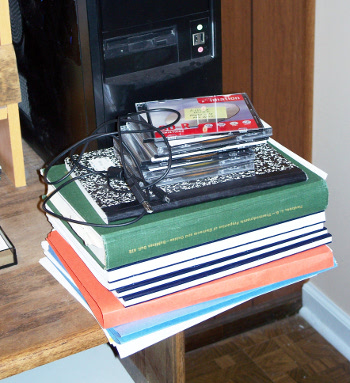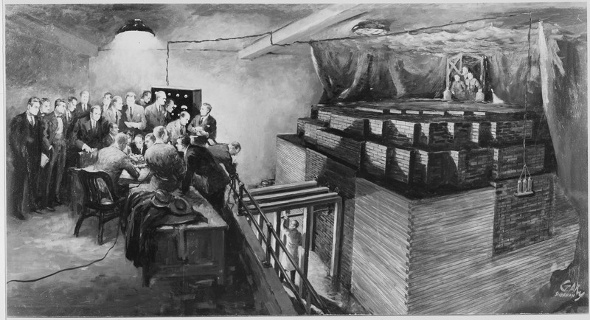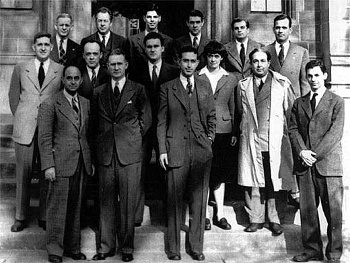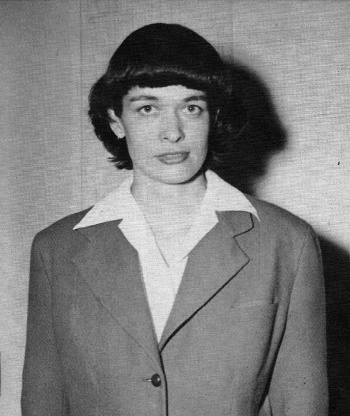The Chicago Pile
January 24, 2014
Scientific discoveries have often derived from piles. As a personal example, my office desk has always been piled high with
journal articles important enough to copy and save, but not important enough at the time to actually read. Then, I spill my
coffee, frantically remove some piles, and accidentally uncover a paper that leads to a new series of
experiments.

Piled higher and deeper.
The usual warning is that desktop computers need proper cooling, so their ventilation holes should never be blocked.
Today, data centers run their servers hot, since it's cheaper to replace them than pay the energy cost for cooling.
(Photo of a corner of the author's desk.)
Possibly the first observation of a scientific
phenomenon in a pile was when
early man noticed that piles of
decaying vegetation generated
heat. Compost piles will regularly reach internal
temperatures of 150°
F (65°
C). This is because of the action of
thermophilic bacteria, some of which can survive at 250°F (120°C).
Then there's the story of the discovery of
stainless steel in a pile of rejected
alloy specimens. The story is possibly
apocryphal, but such stories are usually much more interesting than the real
history. As the story goes,
English scientist,
Harry Brearley, was doing routine testing of different alloy compositions in order to find one with a greater
erosion resistance. After a while, he noticed that his pile of rejected specimens had all
rusted, except for one. This
chromium-containing specimen marked the
invention of stainless steel.
Another famous pile is
Alessandro Volta's voltaic pile, which was the first
electric battery. Volta's pile was an interleaved assemblage of
copper and
zinc discs with
felt pads soaked in
salt water inserted between alternate disc pairs. The salt water
electrolyte created
electrochemical cells between each set of copper and zinc discs, and these produced a
voltage which was multiplied according to the number of disc pairs on the pile.
I would claim that the most famous pile is the
Chicago Pile, sometimes called the Chicago Pile-1 (CP-1) to distinguish it from its successors. This was the world's first
nuclear reactor, although you wouldn't know it by looking at it. It was a pile of
graphite blocks containing
uranium fuel, the graphite acting as a
neutron "
moderator."[1-2]
CP-1 was one of the world's first "
Big Science" experiments, and it was part of the
Manhattan Project. Its
principal investigators were
physicists Enrico Fermi; and,
Leó Szilárd, who had conceived the idea of a
nuclear chain reaction. The reactor achieved a sustained
nuclear reaction at about 3:25 PM on December 2, 1942.[1]

An artist's recreation of the Chicago pile's first sustained reaction on December 2, 1942, at 3:22 PM. The world's first nuclear reactor was housed in the Racquets Court under West Stands of Stagg Field, the University of Chicago. No photographers were present, possibly for security reasons. This recreation was done fifteen years after the fact. (National Archives and Records Administration image, via Wikimedia Commons.)
This
milestone was communicated to
James Conant,
chairman of the
National Defense Research Committee, by
Arthur Compton, who was head of the University of Chicago
Metallurgical Laboratory in which Fermi and
Szilárd's experiment took place. Compton and Conant used the following impromptu
code,
Compton: The Italian navigator has landed in the New World.
Conant: How were the natives?
Compton: Very friendly.[3,5]
The
Italian navigator was Fermi, but
first mate Szilárd was not mentioned. I guess there was nothing in the
code book for a portly
Hungarian.
The pile, which produced only enough
power to light a
light bulb, was 19
feet high, 24 feet wide, and 24 feet long, containing 385.5
tons of graphite, along with 46.5 tons of uranium
metal and
oxides.[1] Preparatory to starting the pile reaction, there were about thirty
subcritical experiments, and all this attention to detail was vindicated when a neutron-absorbing
control rod made of
indium,
cadmium, and
silver was withdrawn from the reactor core, allowing the controlled
chain reaction.[2]
Aside from the control rod, there was an additional safety mechanism of buckets filled with a cadmium
salt solution which could be poured onto the reactor to stop the reaction. Fermi let the reaction proceed for eighteen minutes, and then the control rod was re-inserted.[2] The Chicago Pile was a prototype for reactors to be used in the production of
plutonium for bombs.

The University of Chicago CP-1 reactor team. Enrico Fermi is front row left, while Leó Szilárd is rightmost in the center row.
The sole woman in the photograph, Leona Woods, was also a physicist.
(Via Wikimedia Commons.)
One interesting thing about the photograph of the CP-1 team, as shown above, is the presence of a woman,
Leona Woods (August, 1919 - November, 1986, also known by her married names, Leona Woods Marshall and Leona Woods Marshall Libby). Even today, women are a rarity in the
STEM fields (
science,
technology,
engineering, and
mathematics). As
Barbie so famously stated,
"Math class is tough!". I wrote about this in two previous articles,
Sexism in Science, September 28, 2012, and Math is Tough, but Boys are Tougher, August 6, 2012.
Leona Woods received a B.S. degree in chemistry from the University of Chicago in 1938, at the young age of 19. She had decided to continue her education in physics, so she became a graduate student of Robert Mulliken. A paper on her thesis work, "On the Silicon Oxide Bands", was published in the Physical Review.[6] As she was finishing her thesis, one of Fermi's colleagues discovered her facility with vacuum equipment, so she was recruited into the CP-1 project to develop boron trifluoride neutron detectors.
Woods was married in 1943, and she became pregnant. She told Fermi, but they decided it would be best for her to hide her condition, lest she be barred from working in a radiation laboratory. After giving birth to a son, she returned to work a few days later. After her war work, she led a peripatetic life, working for the Institute for Advanced Study, Brookhaven National Laboratory, New York University, the University of Colorado Boulder, the RAND Corporation, and UCLA. Woods published more than 200 scientific papers, proving that the "weaker sex" is surely a misnomer.

Leona Woods Marshall in 1946 at the University of Chicago.
This photograph is from the Leona Woods Marshall Libby biography in the book, Uranium People, pp. 182-183.
(Argonne National Laboratory photograph, via Wikimedia Commons.)
![]()
References:
- History of Argonne Reactor Operations, US Department of Energy (PDF File).
- Daniel Terdiman, "How the nuclear age burst onto the world from a squash court," CNET, July 3, 2013.
- Argonne's Nuclear Science and Technology Legacy - The Italian Navigator Lands, Argonne National Laboratory Web Site.
- Chicago Pile 1 (CP-1) 70th Anniversary, December 2, 1942 - December 2, 2012, Argonne National Laboratory Web Site.
- A similar impromptu code was used to announce the successful test of centimetric radar at the MIT Radiation Laboratory. Radar signals had been reflected from the spire of the Christian Science temple across the Charles River, and the coded message was, "We have seen Mary Baker Eddy with one eye," the one eye being the radar dish antenna. See Philip J. Hilts, "Last Rites for a 'Plywood Palace' That Was a Rock of Science," The New York Times, March 31, 1998, and my previous article about Lee Davenport.
- L. H. Woods, "On the Silicon Oxide Bands," Physical Review, vol. 63, nos. 11-12 (June, 1943), pp. 426-430.
Permanent Link to this article
Linked Keywords: Science; scientific; scientific journal; journal article; coffee; experiment; Piled higher and deeper; server; phenomenon; early man; decomposition; decay; vegetation; heat; compost; temperature; Fahrenheit; F; Celsius; C; thermophile; thermophilic bacteria; stainless steel; alloy; apocrypha; apocryphal; history; English; scientist; Harry Brearley; erosion corrosion; erosion resistance; rust; chromium; invention; Alessandro Volta; Voltaic pile; electric battery; copper; zinc; felt; salt water; electrolyte; electrochemical cell; voltage; Chicago Pile-1; Chicago Pile; nuclear reactor; graphite; uranium; nuclear fuel; fast neutron; neutron; moderator; Big Science; Manhattan Project; principal investigator; physicist; Enrico Fermi; Leó Szilárd; nuclear chain reaction; nuclear reaction; University of Chicago; photographer; security clearance; security; National Archives and Records Administration; Wikimedia Commons; project management milestone; James Conant; chairman; National Defense Research Committee; Arthur Compton; Metallurgical Laboratory; code; Italian; navigator; first mate; code book; Hungarian; power; light bulb; foot; ton; metal; oxide; critical mass; subcritical; control rod; indium; cadmium; silver; nuclear chain reaction; salt; plutonium; Leona Woods; STEM fields; science; technology; engineering; mathematics; Barbie; "Math class is tough!"; Bachelor of Science; B.S. degree; chemistry; physics; postgraduate education; graduate student; Robert Mulliken; academic publishing; paper; thesis; Physical Review; vacuum equipment; boron trifluoride; neutron detector; marriage; pregnancy; pregnant; radiation; laboratory; Institute for Advanced Study; Brookhaven National Laboratory; New York University; University of Colorado Boulder; RAND Corporation; University of California, Los Angeles; UCLA.